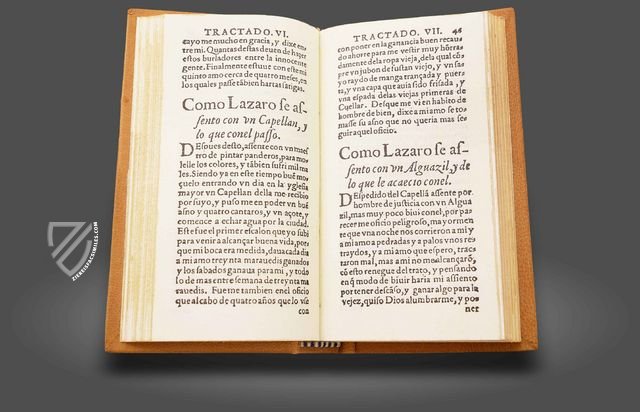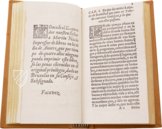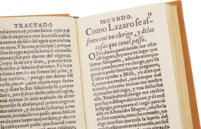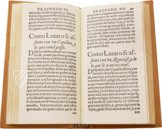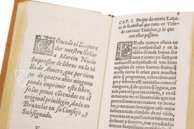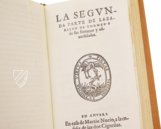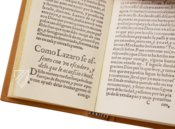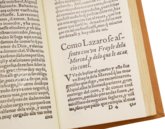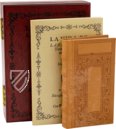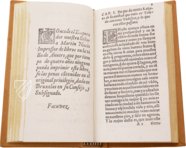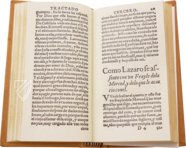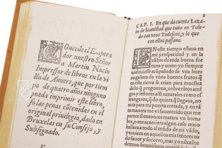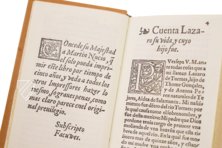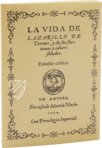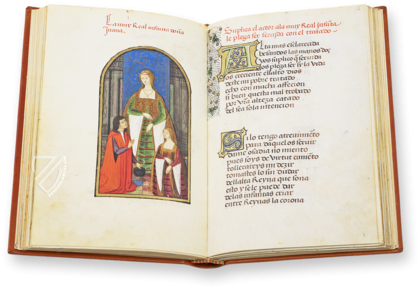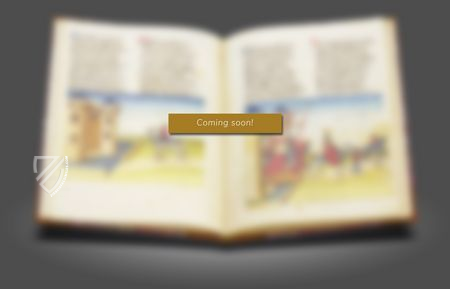Life of Lazarillo de Tormes
(under 1,000€)
The antihero is far from being a modern invention, in fact, the roguish hero was a popular archetype of late medieval literature and an agent for social critique. It is considered to be the first so-called picaresque novel, which took on the hypocrisy and corruption of the Late Middle Ages through a humorous and scathing depiction of society. This novel is both an important piece of Spanish literature and a useful artifact for cultural historians.
Life of Lazarillo de Tormes
Published anonymously due to its anticlerical content, the Spanish novella of Lazarillo de Tormes is considered to be the founding work of the picaresque novel, a literary genre with comedic, parodic, and satirical elements. The picaresque novel tells the adventures of a hero (pícaro) who comes from the lower social classes, but knows how to assert himself in a corrupt world with cunning and shrewdness. The anonymous work was written before 1530 and was probably first printed in Burgos in 1552/53. The earliest three printings that survive today all date from the year 1554 and were published in the cities of Alcalá de Henares, Burgos and Amberes.
The Society from the Worm's Eye View
The story of Lazarillo, a boy from poor circumstances in Salamanca, is told in the first person perspective by the hero himself. This life confession is part of a fictional letter that Lazarillo addresses to an unknown reader who is supposed to assist him in a current dispute involving his employer, the archbishop, and his wife. Lazarillo's autobiography depicts, in episodic sequence, the various working conditions through which the boy passes after his mother sends him to apprenticeship, whereby social advancement is ironically accompanied by progressively worse working conditions. Lazarillo develops cunning strategies to assert himself: first he serves a blind beggar, then a clergyman, an impoverished knight, a friar, an indulgence preacher, a chaplain, and an archpriest. **The story thus takes the reader on a journey through 16th-century society and presents it from the worm's-eye view, that is, from the lowly perspective of the social outsider. In this way, the novel form a sharp contrast to the whitewashing romances about knights and shepherds that were still very popular at the time, such as the successful Amadis novel. Here, no fairy-tale wishful world is depicted, but the oppressive reality of living conditions at the bottom end of society. The simple, catchy prose of the Lazarillo novel also contrasts with the linguistically imaginative poetry of other works of the time.
Inspiration for the modern anti-hero.
It is not surprising that this provocative work, which was equally scathing of both the Catholic Church and the Spanish aristocracy, was placed on the Index of Forbidden Books by the Spanish Inquisition after only a short time, in 1559. After that, it could only appear in a purified form as "Lazarillo castigado" (1573); the explosive original version, on the other hand, was not allowed until the 19th century. The work is truly a milestone of the golden age of Spanish literature, the Siglo de Oro, and was translated into several languages during the 16th and 17th centuries. The mischievous figure of Lazarillo de Tormes has had a lasting influence on all other European literatures, and his prominent descendants include Miguel de Cervantes' Don Quixote and Grimmelshausen's Simplicissimus. Even popular anti-heroes of modern film and television (Forrest Gump, for example) are ultimately inspired by and stand in the long tradition of this first Spanish picaro of world literature.
Codicology
- Alternative Titles
- La vida de Lazarillo de Tormes
Leben von Lazarillo de Tormes
La vida de Lazarillo de Tormes, y de sus fortunas y adversidades - Size / Format
- 234 pages / 13.7 × 7.7 cm
- Origin
- Spain
- Date
- 1554
- Epochs
- Style
- Genre
- Language
- Illustrations
- Numerous printed decorated initials
- Content
- Picaresque novel about the fictional character Lazarillo de Tormes
Life of Lazarillo de Tormes
Historiated “Y” Initial
This splendid woodcut initial appearing at the beginning of this work’s prologue is filled with flowering tendrils as well as a small, winged demon – most likely designed to be a nod to the roguish or “devilish” protagonist of the novel. The figure is perched in the crux of the letter and holds on to each of its “branches” as it looks out directly at the reader. There must have been an error either in the creation of the print or the woodcut itself because the upper-right corner appears as though it never properly made contact with the page.
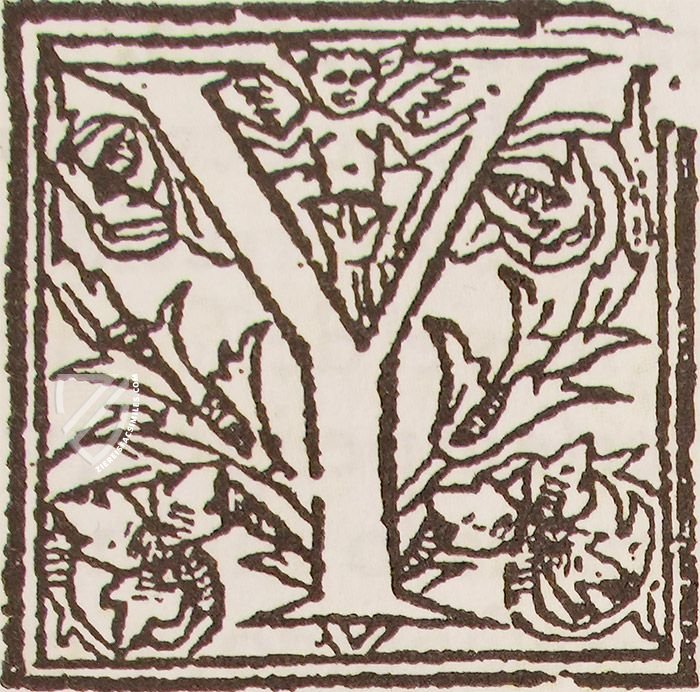
Life of Lazarillo de Tormes
Title Page
This codex originates from the genesis period of book printing when the standard form of title pages as we know them today with the title, author, publisher, location, and year of publication first emerged. Three signatures from previous owners as well as two stamps from the Spanish National library attest to the ownership history of this codex.
In the middle of the page, the printer’s device consists of a stork or some similar long-legged, long-necked wading bird holding a snake in its beak as it lands in its nest, where it feeds the snake to its mate who is guarding their eggs. The motto surrounding the image reads VIRTUS PIETAS HOMINI TUTISSIMA or “Piety is the most secure virtue for men”. This symbol is typically associated with the Verdussen Family of printers.
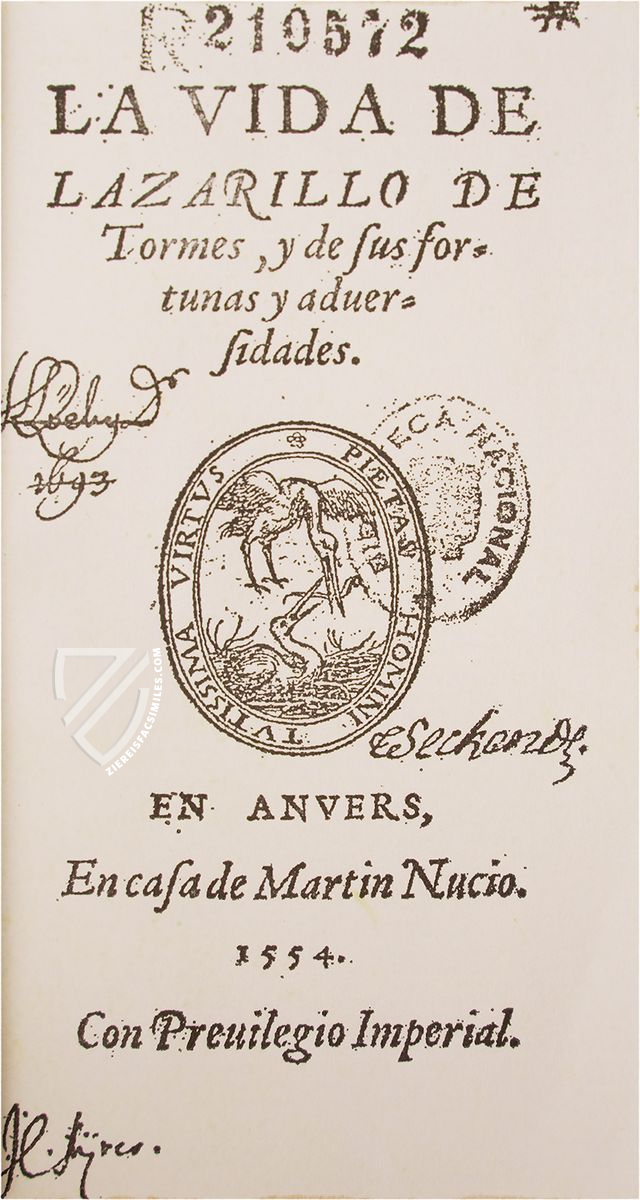
#1 La Vida de Lazarillo de Tormes
Language: Spanish
(under 1,000€)
- Treatises / Secular Books
- Apocalypses / Beatus
- Astronomy / Astrology
- Bestiaries
- Bibles / Gospels
- Chronicles / History / Law
- Geography / Maps
- Saints' Lives
- Islam / Oriental
- Judaism / Hebrew
- Single Leaf Collections
- Leonardo da Vinci
- Literature / Poetry
- Liturgical Manuscripts
- Medicine / Botany / Alchemy
- Music
- Mythology / Prophecies
- Psalters
- Other Religious Books
- Games / Hunting
- Private Devotion Books
- Other Genres
- Afghanistan
- Armenia
- Austria
- Belgium
- Colombia
- Croatia
- Cyprus
- Czech Republic
- Denmark
- Egypt
- Ethiopia
- France
- Germany
- Greece
- Hungary
- India
- Iran
- Iraq
- Israel
- Italy
- Japan
- Lebanon
- Luxembourg
- Mexico
- Morocco
- Netherlands
- Palestine
- Peru
- Poland
- Portugal
- Russia
- Serbia
- Spain
- Sri Lanka
- Sweden
- Switzerland
- Syria
- Turkey
- Ukraine
- United Kingdom
- United States
- Uzbekistan
- Aboca Museum
- Ajuntament de Valencia
- Akademie Verlag
- Akademische Druck- u. Verlagsanstalt (ADEVA)
- Aldo Ausilio Editore - Bottega d’Erasmo
- Alecto Historical Editions
- Alkuin Verlag
- Almqvist & Wiksell
- Amilcare Pizzi
- Andreas & Andreas Verlagsbuchhandlung
- Archa 90
- Archiv Verlag
- Archivi Edizioni
- Arnold Verlag
- ARS
- Ars Magna
- ArtCodex
- AyN Ediciones
- Azimuth Editions
- Badenia Verlag
- Bärenreiter-Verlag
- Belser Verlag
- Belser Verlag / WK Wertkontor
- Benziger Verlag
- Bernardinum Wydawnictwo
- BiblioGemma
- Biblioteca Apostolica Vaticana (Vaticanstadt, Vaticanstadt)
- Bibliotheca Palatina Faksimile Verlag
- Bibliotheca Rara
- Boydell & Brewer
- Bramante Edizioni
- Bredius Genootschap
- Brepols Publishers
- British Library
- C. Weckesser
- Caixa Catalunya
- Canesi
- CAPSA, Ars Scriptoria
- Caratzas Brothers, Publishers
- Carus Verlag
- Casamassima Libri
- Chavane Verlag
- Christian Brandstätter Verlag
- Circulo Cientifico
- Club Bibliófilo Versol
- Club du Livre
- CM Editores
- Collegium Graphicum
- Collezione Apocrifa Da Vinci
- Comissão Nacional para as Comemorações dos Descobrimentos Portugueses
- Coron Verlag
- Corvina
- CTHS
- D. S. Brewer
- Damon
- De Agostini/UTET
- De Nederlandsche Boekhandel
- De Schutter
- Deuschle & Stemmle
- Deutscher Verlag für Kunstwissenschaft
- DIAMM
- Droz
- E. Schreiber Graphische Kunstanstalten
- Ediciones Boreal
- Ediciones Grial
- Ediclube
- Edições Inapa
- Edilan
- Editalia
- Edition Deuschle
- Edition Georg Popp
- Edition Leipzig
- Edition Libri Illustri
- Editiones Reales Sitios S. L.
- Éditions de l'Oiseau Lyre
- Editions Medicina Rara
- Editorial Casariego
- Editorial Mintzoa
- Editrice Antenore
- Editrice Velar
- Edizioni Edison
- Egeria, S.L.
- Eikon Editores
- Electa
- Emery Walker Limited
- Enciclopèdia Catalana
- Eos-Verlag
- Ephesus Publishing
- Ernst Battenberg
- Eugrammia Press
- Extraordinary Editions
- Fackelverlag
- Facsimila Art & Edition
- Facsimile Editions Ltd.
- Facsimilia Art & Edition Ebert KG
- Faksimile Verlag
- Feuermann Verlag
- Folger Shakespeare Library
- Franco Cosimo Panini Editore
- Friedrich Wittig Verlag
- Fundación Hullera Vasco-Leonesa
- G. Braziller
- Gabriele Mazzotta Editore
- Gebr. Mann Verlag
- Gesellschaft für graphische Industrie
- Getty Research Institute
- Giovanni Domenico de Rossi
- Giunti Editore
- Graffiti
- Grafica European Center of Fine Arts
- Guido Pressler
- Guillermo Blazquez
- Gustav Kiepenheuer
- H. N. Abrams
- Harrassowitz
- Helikon
- Hendrickson Publishers
- Henning Oppermann
- Herder Verlag
- Hes & De Graaf Publishers
- Hoepli
- Holbein-Verlag
- Hortus Deliciarum
- Houghton Library
- Hugo Schmidt Verlag
- Idion Verlag
- Il Bulino, edizioni d'arte
- ILte
- Imago
- Insel Verlag
- Instituto Nacional de Antropología e Historia
- Istituto dell'Enciclopedia Italiana - Treccani
- Istituto Ellenico di Studi Bizantini e Postbizantini
- Istituto Geografico De Agostini
- Istituto Poligrafico e Zecca dello Stato
- Italarte Art Establishments
- J. Thorbecke
- Jan Thorbecke Verlag
- Johnson Reprint Corporation
- Josef Stocker
- Josef Stocker-Schmid
- Jugoslavija
- Karl W. Hiersemann
- Kasper Straube
- Kaydeda Ediciones
- Kindler Verlag / Coron Verlag
- Kodansha International Ltd.
- Konrad Kölbl Verlag
- Kurt Wolff Verlag
- La Liberia dello Stato
- La Linea Editrice
- La Meta Editore
- Lambert Schneider
- Landeskreditbank Baden-Württemberg
- Leo S. Olschki
- Les Incunables
- Library of Congress
- Libreria Musicale Italiana
- Lichtdruck
- Lito Immagine Editore
- Lumen Artis
- Lund Humphries
- M. Moleiro Editor
- Maison des Sciences de l'homme et de la société de Poitiers
- Manuscriptum
- Martinus Nijhoff
- Maruzen-Yushodo Co. Ltd.
- MASA
- McGraw-Hill
- Militos
- Millennium Liber
- Müller & Schindler
- Nahar and Steimatzky
- National Library of Wales
- Neri Pozza
- Nova Charta
- Oceanum Verlag
- Odeon
- Orbis Mediaevalis
- Orbis Pictus
- Österreichische Staatsdruckerei
- Oxford University Press
- Pageant Books
- Parzellers Buchverlag
- Patrimonio Ediciones
- Pattloch Verlag
- PIAF
- Pieper Verlag
- Plon-Nourrit et cie
- Prestel Verlag
- Princeton University Press
- Prisma Verlag
- Priuli & Verlucca, editori
- Pro Sport Verlag
- Propyläen Verlag
- Pytheas Books
- Quaternio Verlag Luzern
- Reales Sitios
- Recht-Verlag
- Reichert Verlag
- Reichsdruckerei
- Riehn & Reusch
- Roberto Vattori Editore
- Rosenkilde and Bagger
- Roxburghe Club
- Salerno Editrice
- Sarajevo Svjetlost
- Schöck ArtPrint Kft.
- Scolar Press
- Scrinium
- Scripta Maneant
- Scriptorium
- Siloé, arte y bibliofilia
- SISMEL - Edizioni del Galluzzo
- Sociedad Mexicana de Antropología
- Société des Bibliophiles & Iconophiles de Belgique
- Soncin Publishing
- Sorli Ediciones
- Stainer and Bell
- Studer
- Styria Verlag
- Sumptibus Pragopress
- Szegedi Tudomànyegyetem
- Taberna Libraria
- Tarshish Books
- Taschen
- Tempus Libri
- Testimonio Compañía Editorial
- Thames and Hudson
- The Clear Vue Publishing Partnership Limited
- The Facsimile Codex
- The Folio Society
- The Marquess of Normanby
- The Richard III and Yorkist History Trust
- Tip.Le.Co
- TouchArt
- TREC Publishing House
- TRI Publishing Co.
- Trident Editore
- Typis Regiae Officinae Polygraphicae
- Union Verlag Berlin
- Universidad de Granada
- University of California Press
- University of Chicago Press
- Urs Graf
- Vallecchi
- Van Wijnen
- VCH, Acta Humaniora
- VDI Verlag
- VEB Deutscher Verlag für Musik
- Verlag Anton Pustet / Andreas Verlag
- Verlag Bibliophile Drucke Josef Stocker
- Verlag der Münchner Drucke
- Verlag für Regionalgeschichte
- Verlag Styria
- Vicent Garcia Editores
- W. Turnowsky
- Waanders Printers
- Wiener Mechitharisten-Congregation (Wien, Österreich)
- Wissenschaftliche Buchgesellschaft
- Wydawnictwo Dolnoslaskie
- Xuntanza Editorial
- Zakład Narodowy
- Zollikofer AG

